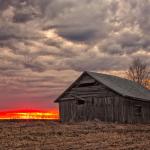 In his book, The Elementary Forms of Religious Life, sociologist Emile Durkheim begins his study of religion by noting that central to all religions is a distinction between the sacred and the profane and that religion has to do with sacred things.
In his book, The Elementary Forms of Religious Life, sociologist Emile Durkheim begins his study of religion by noting that central to all religions is a distinction between the sacred and the profane and that religion has to do with sacred things.
Mircea Eliade in his book, The Sacred and Profane, provides details on the range of objects and subjects that various peoples throughout the world have considered sacred. He divides the topic by sacred places and objects, sacred times, and sacred people.
That early people should find places such as Devils Tower, Wyoming; Shiprock, New Mexico; or the Grand Canyon (to name a few that I’ve visited) is not surprising. Such places still have a strong effect on us. Modern aesthetics includes the label of the sublime for such places, places that stand out so strikingly against the ordinary landscapes that we can’t help but be fascinated by them.
Yet many objects and places considered sacred are rather ordinary. Sacred trees, sacred stones, sacred springs are common in traditional religions around the world. The range of objects across the globe that are considered sacred are bewilderingly varied. (In an article I published here on Dec. 7, 1917, titled “The Spirit Tree,” I discuss one such object, a tree considered sacred by the Chippewas of Northern Minnesota). That such objects are found throughout the globe and to the beginning of recorded history and earlier, tells us that the idea of the sacred reveals a deep tendency in human nature, irrational as we moderns might find the idea.
* * *
In his Religion in Essence and Manifestation, Gerardus van der Leeuw writes: “the first affirmation we can make about the Object of Religion is that it is a highly exceptional and extremely impressive ‘other’.” He adds that this “Object” is “a departure from all that is usual and familiar.” In other words, a departure from the ordinary “profane” world. Van der Leeuw goes on to say that what makes these objects of religion exceptional is the perception that they contain some kind of power, they draw our attention.
From a naturalistic perspective, this “power to draw our attention” cannot be an objective aspect of the world the way a magnet’s power to draw objects is. What’s sacred to one group is meaningless to another. There is nothing that has universally been held sacred(1). And if not an objective aspect, then it must be either inter-subjective or subjective.
From all of this, the obvious conclusion seems to be: nothing is really sacred. But should we jump to that conclusion? We might consider the less obvious conclusion: “everything is sacred.”
Van der Leeuw says that sacred objects draw our attention. If this is correct then, from a naturalistic perspective, it means that the difference between the sacred and profane must be a matter of our attention, of our caring.
Everything is sacred when we see it through the mind of sacred attentiveness. Everything is profane when seen through a mind of profane attention. There is a saying in Buddhism that “nirvana and samsara are one and the same” which suggest this idea. The Naturalistic equivalent of this might be “the sacred and profane are one and the same.” The difference between nirvana and samsara, like the difference between the sacred and the profane, belongs not to the world, but to the mind in its perceiving of the world.
To relate to the world through our ego, through our selfishness, is to relate to the world with a profane mind. To relate through love, selflessness or a non-dualistic wholeness, is to relate with a sacred mind. Spiritual teachings throughout the world, despite their obvious differences, are rather unified in suggesting this.
* * *
We all have the viewpoint of the profane. It is the natural viewpoint, the viewpoint that makes us most fit to survive and reproduce. But the sacred viewpoint is not a given. It is a cultural accomplishment. It requires knowledge and discipline. It requires us to go against the grain of our natural instincts. The metaphor of ascent is a commonplace of spiritual traditions. Ascent requires constant effort, to go with gravity is our natural inclination. The metaphor of ascent is a reminder of the effort required by spiritual practice.
This notion, that while we all possess the profane viewpoint only some possess the viewpoint of the sacred is rather troublesome. It creates an inequality, and to introduce such an inequality is not polite. But nonetheless that’s how it is. If one wants to experience the sacred viewpoint, one has to seek it and be prepared for the work and sacrifice that it entails. And part of what must be sacrificed are the assumptions that support the profane viewpoint.
* * *
To experience the sacred violates no principle of naturalism. Because of the particular conditions in which modern science developed, it had to struggle against the power of religion, both its symbolic power and its political power. Against “the enchantment” of its symbolic power, science provided facts that had the effect of creating a “disenchantment” of the world. But this sense of disenchantment is not a necessary outcome. Had science arose in different circumstances, its discovery of the marvelous way that the Universe has self-organized may have been found utterly enchanting. As a friend recently said to me, “I think science makes everything seem like a miracle.” The discoveries of science can greatly enhance our awareness and attentiveness to this world, and that can move us to seeing the world in a more sacred light.
Subscribe to The Spiritual Naturalist Society
Learn about Membership in the Spiritual Naturalist Society
__________
The Spiritual Naturalist Society works to spread awareness of spiritual naturalism as a way of life, develop its thought and practice, and help bring together like-minded practitioners in fellowship.
Notes: 1. In the United States, the one “sacred” thing that the various factions of our society might agree on is in considering burial grounds sacred. If someone comes up with a plan to convert a graveyard or cemetery into a shopping mall, I suspect this would create considerable outrage across ideologies. Unfortunately, this concern with the sacredness of burial grounds doesn’t extend to those of the original inhabitants of this country, which are routinely bull-dozed despite the pleas and protests of Native American peoples.
















